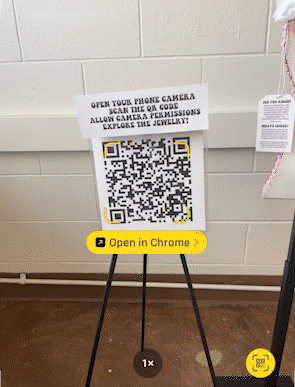REWEAR
REWEAR is a collection that represents a transparent, sustainable future for festival fashion. Displayed as an installation, this collection reflects on the carbon footprint left by festivals and the role fashion plays. Each item was created with sustainable materials and is brought to life through augmented reality interactions.
Many fast fashion companies greenwash, which is conveying a false impression or providing misleading information about how their products are more environmentally sound for marketing purposes but actually aren't making any notable sustainability efforts.
I wanted to understand how materials and technologies can be utilized to create festival fashion in the most sustainable and transparent way from start to finish. All materials were sourced locally and animations in augmented reality illustrate environmental problems at festivals and why the materials for each piece were chosen.
The first piece is a pair of patchwork overalls. These overalls are made from fabric remnants. Remnants are scraps of leftover fabric that would have been discarded. All materials, including hardware, were sourced locally from Art Parts. You can find a breakdown of the cost of materials here. The statistic that goes along with this piece is that "Every second, the equivalent of one garbage truck of textiles is landfilled or burned" (UN Environmental Program). I decided to have flames appear on top of the overalls to represent this statistic. You can learn more about the process for making the overalls here.



The second piece I made was a recycled plastic vest filled with soft low-density polyethylene (LDPE) plastics. These cannot be easily recycled and are a common plastic found at festivals that end up in landfills. The vest’s shell is made from donated plastic vinyl that also would have been thrown away. You can find the process for the vest here and a breakdown of materials here. The statistic for this piece is that "In the United States, festival-goers produce 53,000 tons of waste each year. For context, the average American produces about one ton of waste per year" (CNN). I wanted to represent this piece by showing the different types of plastics that could be found, so the animation consists of straws, utensils, and water bottles.



The final piece is a set of earrings and a necklace made from bioplastic which is biodegradable. This Bioplastic was made with water, glycerol, gelatin, and natural coloring (turmeric, beets, and blue spirulina). You can find my methods for making bioplastic here and here as well as a breakdown of material costs here. I followed the recipe from the Bioplastic Cookbook. If these items were discarded, they would not cause further harm to the environment and instead would allow for new growth. The statistic I chose for these is "Festivalgoers discard clothing, glitter, and countless other items made from polymers that can persist in the environment for decades if not centuries" (BBC). For the animation, I wanted to represent the growth that could come from bioplastic with moving flowers.





